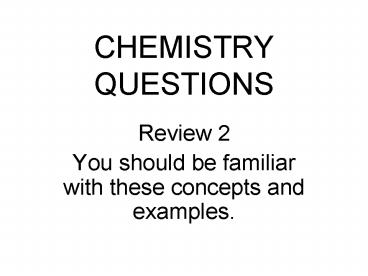CHEMISTRY QUESTIONS - PowerPoint PPT Presentation
1 / 48
Title:
CHEMISTRY QUESTIONS
Description:
Draw the first two levels of a cloud diagram with 2 levels of electrons full and ... Which subatomic particles make up most of the mass of an atom? Q20 ... – PowerPoint PPT presentation
Number of Views:38
Avg rating:3.0/5.0
Title: CHEMISTRY QUESTIONS
1
CHEMISTRY QUESTIONS
- Review 2
- You should be familiar with these concepts and
examples.
2
Q1
- On the periodic table, which are families and
which are periods?
3
Q2
- Draw the first two levels of a cloud diagram with
2 levels of electrons full and the nucleus
labeled.
4
Q3
- What is an isotope?
5
Q4
- What is the maximum number of dots that can be
in a dot diagram?
6
Q5
- Which represents a family/group in the Periodic
Table? (rows or columns)
7
Q6
- What do elements in a column have in common?
8
Q7
- How is the Periodic Table arranged?
9
Q8
- What are the max number of electrons in each
orbital, s, p, d, and f?
10
Q9
- Label the orbitals
Increasing Energy
11
Q10
- Write the electron configuration of Br
12
Q11
- Write the noble gas form electron configuration
of Cl
13
Q12
- What is the electron configuration of Na ?
14
Q13
- What is the first element that has an electron in
the f orbital?
15
Q14
- Why does Helium appear above the Noble gasses?
16
Q15
- Why are noble gasses called noble gasses?
17
Q16
- What is the symbol for potassium?
18
Q17
- What is a positively charged particle called?
19
Q18
- What charge does a neutron have?
20
Q19
- Which subatomic particles make up most of the
mass of an atom?
21
Q20
- Where is most of the mass of an atom found?
22
Q21
- What kind of a charge do atoms (as represented on
the periodic table) have overall?
23
Q22
- Is this correct?
- He 4 protons, 4 electrons
- If not, propose the correct numbers.
24
Q23
- If an element has the atomic number of 26 it has
26 what?
25
Q24
- How do you calculate the number of neutrons in an
atomic nucleus.
26
Q25
- All atoms of the same element have the same
number of.
27
Q26
- Draw the dot diagram for Fluorine
28
Q27
- What is the name of the family with 2 oxidation
number?
29
Q28
- Using the periodic table how do you calculate
number of electrons?
30
Q29
- What word describes any matter made up of one
kind of atom?
31
Q30
- What is a valence electron?
32
Q31
- Are there any atomic symbols written with 3
letters?
33
Q32
- Electrons in orbitals are found in _____ and
spinning in ______directions
34
Q33
- List the symbols of the 6 elements in the 2p
block?
35
Q34
- You can not fill the 4s orbital until you have
filled.
36
Name the following compounds
- 1-4HF LiH HNO2 Hg2Cl2
- 5-8Na2CrO7 CuBrO3 BaCl2 KMnO4
- 9-12PbCrO4 PF3 Ba(NO2)2 SO3
- 13-16Ca(NO3)2 CO NaHCO3 CCl4
- 17-20Al(HSO3)3 NO2 H2SO4 NaCl
- 21-24Fe3(PO4)2 Au(NO3)3 H2S Sr(OH)2
37
Q36
- How many types of atoms and how many of each kind
are in - NaAs4COCo3F6
38
Q37
- Predict the products of the following single
displacement reaction - Zn PbI2 ?
39
Q38
- Define atom
40
Q39
- Homogenous mixtures differ from heterogeneous
mixtures in what ways?
41
Q40
- What do the following state of matter symbols
mean? - (s)
- (l)
- (g)
- (aq)
42
Q41
- How many significant figures are in
- (a) 1.0080
- (b) 0.0067
- ( c) 200
43
Q42
- Fill in the correct conversion factors
- 1 kg ______ dg
- 100 cm ______ m
- 1 L ______ kL
44
Q43
- Draw the particle arrangements of a substance as
a solid, liquid, and gas in the labeled boxes
below. - Solid Liquid Gas
45
Q44
- Find the electronegativity differences and
predict the bond types of each of the following - (a) CO
- (b) CoF2
- ( c) N2
- (d) AlP3
46
Q45
- Use the Lewis Dot method to draw the correct
bonding in CaCl2
47
Q46
- Use the Lewis Dot method to draw the correct
bonding in H2O
48
Q47
- Use the Lewis Dot method to draw the correct
bonding in CH3CH2CHCl2































